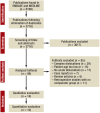The treatment of simple elbow dislocation in adults
- PMID: 26037467
- PMCID: PMC4455254
- DOI: 10.3238/arztebl.2015.0311
The treatment of simple elbow dislocation in adults
Abstract
Background: Simple elbow dislocation is a complex soft-tissue injury that can cause permanent symptoms. Its incidence is 5 to 6 cases per 100 000 persons per year. Its proper treatment is debated; options range from immobilization in a cast to surgical intervention.
Methods: We systematically reviewed the literature on the treatment of simple elbow dislocation and performed a meta-analysis, primarily on the basis of clinical scores and secondarily with respect to pain, range of motion, and return to work.
Results: A randomized controlled trial (RCT) showed that clinical results at short-term follow-up were superior for early functional treatment compared to immobilization in a cast. Brief immobilization, however, reduced pain initially, and the long-term results of early mobilization and immobilization in a cast were the same. Our meta-analysis showed that early mobilization enables patients to return to work earlier (difference of mean values -2.91, 95% confidence interval [CI] -3.18 to -2.64), and that the extent of soft-tissue injury is correlated with the clinical outcome (inverse relationship; difference of mean values -12.07, 95% CI -23.88 to -0.26). Surgical and conservative treatment were compared in a single RCT, which revealed no significant difference in outcomes. A meta-analysis of two retrospective comparative studies showed no advantage of immediate ligament repair over delayed surgery.
Conclusion: Early functional treatment is the evidence-based therapeutic standard for simple elbow dislocation. The past few years have seen further developments in surgery for simple elbow dislocation. Further study is needed to determine whether surgery for elbow dislocation with high-grade instability can prevent persistent pain, limitation of motion, and chronic instability.
Figures


References
-
- Josefsson PO, Nilsson BE. Incidence of elbow dislocation. Acta Orthop Scand. 1986;57:537–538. - PubMed
-
- Kroner K, Lind T, Jensen J. The epidemiology of shoulder dislocations. Arch Orthop Trauma Surg. 1989;108:288–290. - PubMed
-
- Stoneback JW, Owens BD, Sykes J, Athwal GS, Pointer L, Wolf JM. Incidence of elbow dislocations in the United States population. J Bone Joint Surg Am. 2012;94:240–245. - PubMed
-
- Hovelius L. Incidence of shoulder dislocation in Sweden. Clin Orthop Relat Res. 1982;166:127–131. - PubMed
-
- Fitzpatrick MJ, Diltz M, McGarry MH, Lee TQ. A new fracture model for „terrible triad“ injuries of the elbow: influence of forearm rotation on injury patterns. J Orthop Trauma. 2012;26:591–596. - PubMed
Publication types
MeSH terms
LinkOut - more resources
Full Text Sources
Other Literature Sources
Medical
Miscellaneous

